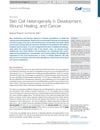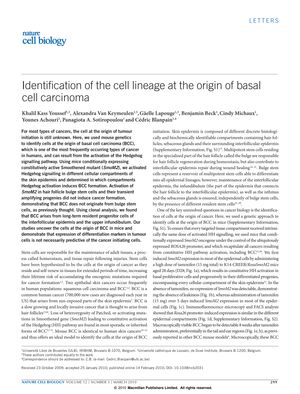TLDR Basal cell carcinoma mostly starts from cells in the upper skin layers, not hair follicle stem cells.
The document from 2010 reports on a study that investigated the origin of basal cell carcinoma (BCC) in mice. The researchers used genetic mouse models to activate Hedgehog signaling in different skin compartments and found that BCC does not originate from hair follicle bulge stem cells. Instead, BCC arises from long-term resident progenitor cells of the interfollicular epidermis and the upper infundibulum. Clonal analysis showed that 93% of BCCs originated from interfollicular epidermis cells, and the expression of Smoothened (SmoM2) in these cells was sufficient to induce BCC formation. The study suggests that the characteristics of tumor cells may not accurately indicate the cancer-initiating cells and highlights the potential relevance of these findings to human BCC, given the similarities between mouse and human BCC and the likelihood of ultraviolet light affecting interfollicular epidermis cells. Quantitative PCR analysis was used to measure gene expression, and a minimum of 110 pilosebaceous units from three separate mice were analyzed for one group, with a minimum of 125 units from two different mice for other groups, and 1,380 units from two different mice for the ShhCREER/RosaSmoM2 mice. The study aimed to identify the specific cell types within the pilosebaceous unit that give rise to BCC when expressing the SmoM2 mutation.
503 citations
,
May 2009 in “Cell stem cell” Lrig1 marks a unique group of stem cells in mouse skin that can become different skin cell types.
 1039 citations
,
February 2009 in “Nature Reviews Molecular Cell Biology”
1039 citations
,
February 2009 in “Nature Reviews Molecular Cell Biology” Skin stem cells are crucial for maintaining and repairing the skin and hair, using a complex mix of signals to do so.
207 citations
,
July 2006 in “Development” MTS24 marks a new type of skin cell that helps hair growth and repair.
1279 citations
,
November 2005 in “Nature Medicine” 387 citations
,
November 2003 in “Journal of Investigative Dermatology” The K15 promoter effectively targets stem cells in the hair follicle bulge.
421 citations
,
September 2003 in “Development” Stem cell behavior varies with stimuli, and lineage changes can happen without affecting stem cell division.
638 citations
,
October 1997 in “Nature”
 17 citations
,
June 2017 in “British Journal of Dermatology”
17 citations
,
June 2017 in “British Journal of Dermatology” The article concludes that hair loss is a common side effect of drugs treating skin cancer by blocking the hedgehog pathway, but treatment should continue, and more selective drugs might prevent this side effect.
 7 citations
,
February 2022 in “Stem cell reviews and reports”
7 citations
,
February 2022 in “Stem cell reviews and reports” Skin cells show flexibility in healing wounds and forming tumors, with potential for treating hair disorders and chronic ulcers.
 8 citations
,
March 2014 in “American Journal of Pathology”
8 citations
,
March 2014 in “American Journal of Pathology” Damaged hair follicles make mice more prone to skin inflammation and skin cancer after UV exposure.
 211 citations
,
May 2018 in “Trends in cell biology”
211 citations
,
May 2018 in “Trends in cell biology” Different types of skin cells play specific roles in development, healing, and cancer.
 85 citations
,
July 2012 in “Cold Spring Harbor perspectives in biology”
85 citations
,
July 2012 in “Cold Spring Harbor perspectives in biology” The skin protects the body and is constantly renewed by stem cells; disruptions can lead to cancer.








